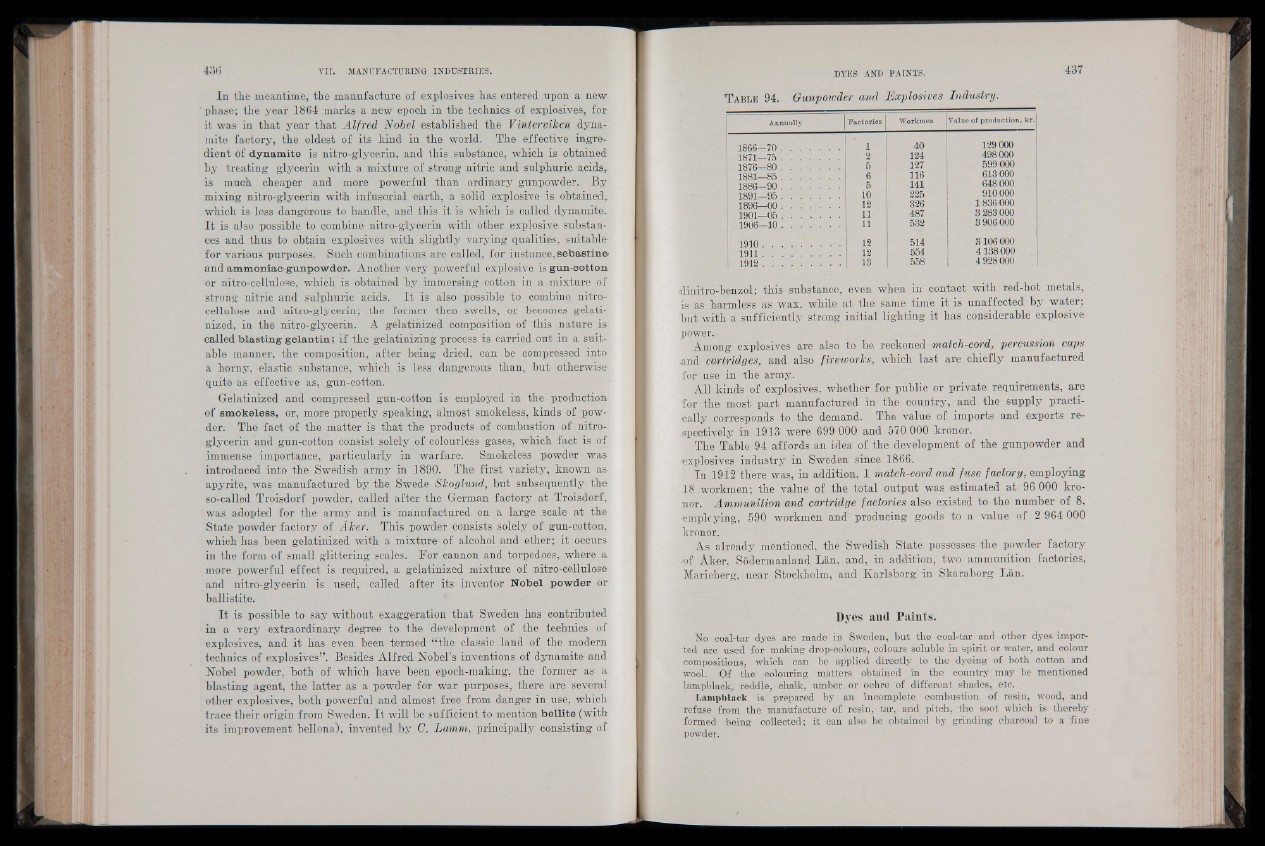
In the meantime, the manufacture of explosives has entered upon a new
phase; the year 1864 marks- a new epoch in the technics of explosives, for
it was in that year that Alfred Nobel established the Vinterviken dynamite
factory, the oldest of its kind in the world. The effective ingredient
of dynamite is nitro-glycerin, and this substance, which is obtained
by treating glycerin with a mixture of strong nitric and sulphuric acids,
is much cheaper and more powerful than ordinary gunpowder. By
mixing nitro-glycerin with infusorial earth, a solid explosive is obtained,
which is less dangerous to handle, and this it is which is called dynamite.
It is also possible to combine nitro-glycerin with other explosive substances
and thus to obtain explosives with slightly varying qualities, suitable
for various purposes. Such combinations are called, for instance, seb a stin e
and ammoniac-gunpowder. Another very powerful explosive is gun-cotton
or nitro-cellulose, which is obtained by immersing cotton in a mixture of
strong nitric and sulphuric acids. It is also possible to combine nitrocellulose
and nitro-glycerin; the former then swells, or becomes gelatinized,
in the nitro-glycerin. A gelatinized composition of this nature is
called blasting gelantin ; if the gelatinizing process is carried out in a suitable
manner, the composition, after being dried, can be compressed into
a horny, -elastic substance, which is less dangerous than, but otherwise
quite as effective as, gun-cotton.
Gelatinized and compressed gun-cotton is employed in the production
of smokeless, or, more properly speaking, almost smokeless, kinds of powder.
The fact of the matter is that the products of combustion of nitroglycerin
and gun-cotton consist solely of colourless gases, which fact is of
immense importance, particularly in warfare. Smokeless powder was
introduced into the Swedish army in 1890. The first variety, known as
apyrite, was manufactured by the Swede Skoglund, but subsequently the
so-called Troisdorf powder, called after the German factory at Troisdorf,
was adopted for the army and is manufactured on a large scale at the
State powder factory of Aker. This powder consists solely of gun-cotton,
which has been gelatinized with a mixture of alcohol and ether; it occurs
in the form of small glittering scales. For cannon and torpedoes, where a
more powerful effect is required, a gelatinized mixture of nitro-cellulose
and nitro-glycerin is used, called after its inventor Nobe l powder or
ballistite.
It is possible to say without exaggeration that Sweden has contributed
in a very extraordinary degree to the development of . the technics of
explosives, and it has even been termed “the classic land of the modern
technics of explosives”. Besides Alfred Nobel’s inventions of dynamite and
Nobel powder, both of which have been epoch-making, the former as a
blasting agent, the latter as a powder for war purposes, there are several
other explosives, both powerful and almost free from danger in use, which
trace their origin from Sweden. It will be sufficient to mention bellite (with
its improvement bellona), invented by C. Lamm, principally consisting of
T ab le 94. Gunpowder and Explosives Industry.
Annually Factories Workmen Value of production, kr.
-
1866—70 ........................ 1 40 129 000
1871—75 ........................ 2 124 498 000
1876—80 ........................ 5 127 599 000
1881—85 ........................ 6 116 613 000
1886-90 ........................ 5 141 648 000
1891 95 ........................ 10 225 910000
1896 00 ........................ 12 326 1836 000
1901—05 . — — 1 11 487 3 283 000
1906 10 ........................ 11 532 3 906 000
1910................................ ■ 514 3 106 000
1911................................ 12 554 4138000
■ 1912 . . . . . . . . . 13 558 4 928 000
■dinitro-benzol; this substance, even when in contact with red-hot metals,
is as harmless as wax, while at the same time it is unaffected by water;
but with a sufficiently strong initial lighting it has considerable explosive
power.
Among explosives are also to be reckoned match-cord, percussion caps
and cartridges, and also fireworks, which last are chiefly manufactured
for use in the army.
All kinds of explosives, whether for public or private requirements, are
for the most part manufactured in the country, and the supply practically
corresponds to the demand. The value of imports and exports respectively
in 1913 were .699 000 and 570 000 kronor.
The Table 94 affords an idea of the development of the gunpowder and
■explosives industry in Sweden since 1866.
In 1912 there was, in addition, 1 match-cord and fuse factory, employing
18 workmen; the value of the total output was estimated at 96 000 kronor.
Ammunition and cartridge factories also existed to the number of 8,
employing, 590 workmen and producing goods to a value of 2 964 000
kronor.
As already mentioned, the Swedish State possesses the powder factory
■of Aker, Sodermanland Lan, and, in addition, two ammunition factories,
Marieberg, near Stockholm, and Karlsborg in Skaraborg Lan.
Dyes and Paints.
No coal-tar dyes are made in Sweden, but the coal-tar and other dyes imported
are used for making chop colours, colours soluble in spirit or water, and colour
-compositions, which can be applied directly to the dyeing of both cotton and
wool. Of the colouring matters obtained in the country may be mentioned
lampblack, reddle, - chalk, umber or ochre of different shades, etc.
Lampblack is prepared by an incomplete combustion of resin, wood, and
refuse from the manufacture of resin, tar, and pitch, the soot which is thereby
formed being collected; it can also be obtained by grinding charcoal to a fine
powder.